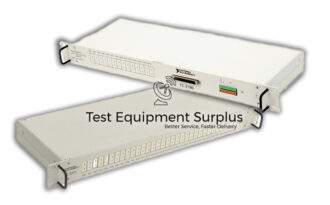Description
The National Instruments PXIe-5842 PXI Vector Signal Transceiver is a state-of-the-art, four-slot PXI Express module designed to meet the demanding requirements of the semiconductor, aerospace, and defense industries. This compact, high-performance device offers unparalleled measurement speed and flexibility, making it an ideal solution for a wide range of applications.
One of the key features of the PXIe-5842 is its compatibility with PXI chassis. Up to four PXIe-5842 VSTs can be seamlessly integrated into a single 18-slot PXI chassis, providing users with a scalable solution that can be tailored to meet their specific needs. This level of integration and scalability is particularly beneficial in high-stakes environments where precision and reliability are paramount.
In terms of technical specifications, the PXIe-5842 supports cutting-edge standards such as Wi-Fi 7 and 5G NR, among others. This ensures that users are equipped with the technology needed to tackle the challenges of modern wireless communication. The device comes in various part numbers and frequencies, including 788566-02 (54 GHz), 788565-01 (23 GHz), 788565-02 (12 GHz), and 788565-03 (8 GHz), offering a range of options to suit different application requirements.
The PXIe-5842 is built for real-time, FPGA-based signal processing. This capability allows for high-speed data analysis and processing, enabling users to achieve fast measurement speeds without compromising on accuracy or performance. Additionally, the device offers comprehensive API support, including RFmx, NI-RFSG, and NI-RFSA, and is compatible with a variety of programming languages such as LabVIEW, LabWindows™/CVI, C/C++, C# (.NET), and InstrumentStudio. This wide range of software support allows for easy integration into existing systems and flexibility in programming and customization.
To ensure optimal performance, the PXIe-5842 requires the installation of the appropriate driver version. Moreover, the module must be installed in a specific order and orientation within the chassis. The chassis itself must meet certain requirements regarding capacity, power, and slot cooling capacity to accommodate the PXIe-5842’s needs. These requirements underscore the importance of considering the overall system configuration to achieve the best possible performance and reliability.
In summary, the National Instruments PXI
| Specification | Details |
|---|---|
| Product | National Instruments PXIe-5842 PXI Vector Signal Transceiver |
| Form Factor | Four-slot PXI Express |
| Compatibility | Up to four PXIe-5842 VSTs can be fitted into a single 18-slot PXI chassis |
| Applications | Semiconductor, aerospace, and defense industries |
| Measurement Speed | Fast |
| Form Factor | Compact |
| Performance | High |
| Flexibility | High |
| Standards Supported | Wi-Fi 7, 5G NR, and more |
| Part Numbers and Frequencies | 788566-02 (54 GHz), 788565-01 (23 GHz), 788565-02 (12 GHz), 788565-03 (8 GHz) |
| Signal Processing | FPGA-based, real-time |
| API Support | RFmx, NI-RFSG, NI-RFSA |
| Programming Languages Supported | LabVIEW, LabWindows™/CVI, C/C++, C# (.NET), InstrumentStudio |
| Driver Installation | Requires appropriate driver version |
| Module Installation Requirement | Specific order and orientation |
| Chassis Requirements | Capacity, power, and slot cooling capacity must meet PXIe-5842 requirements |
Question 1: What industries is the PXIe-5842 designed for?
Answer 1: Semiconductor, aerospace, and defense.
Question 2: How many PXIe-5842 VSTs fit in an 18-slot PXI chassis?
Answer 2: Up to four.
Question 3: Does the PXIe-5842 support Wi-Fi 7 and 5G NR?
Answer 3: Yes, it supports both.
Question 4: What is the part number for the 54 GHz frequency model?
Answer 4: 788566-02.
Question 5: What programming languages is the PXIe-5842 compatible with?
Answer 5: LabVIEW, C/C++, C#, and more.



